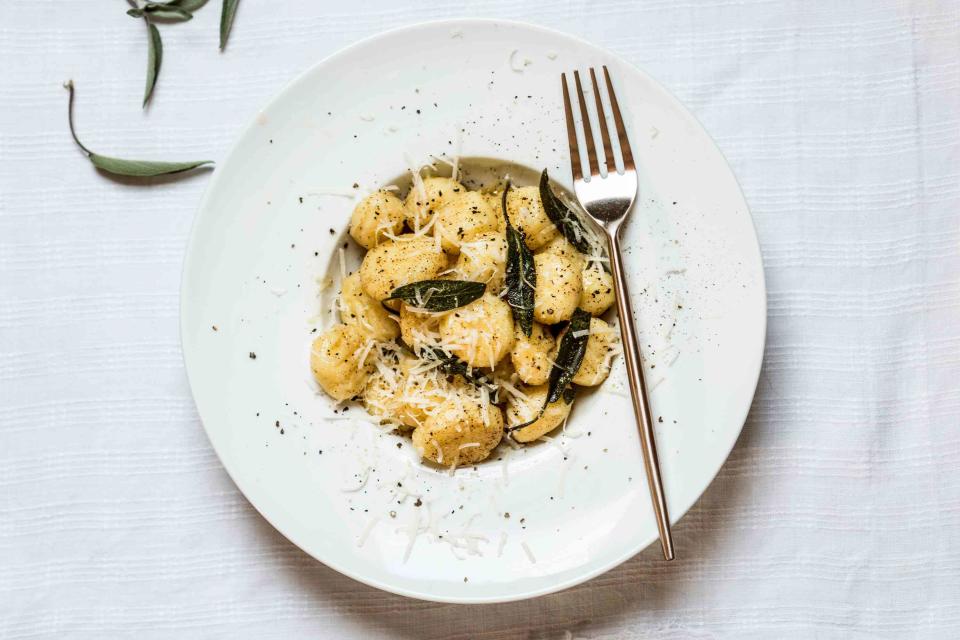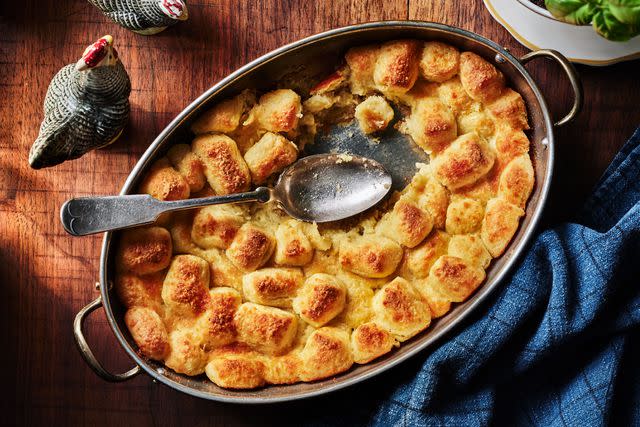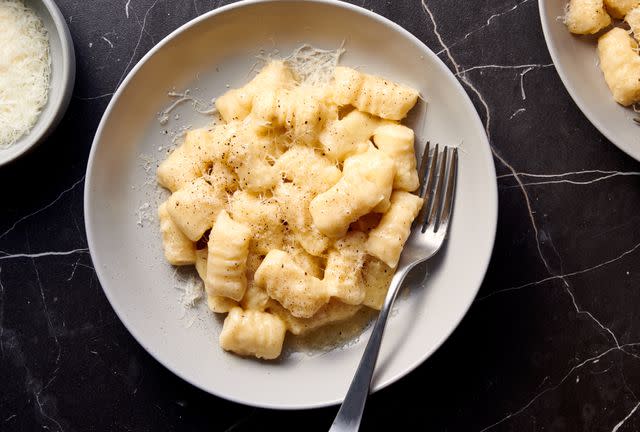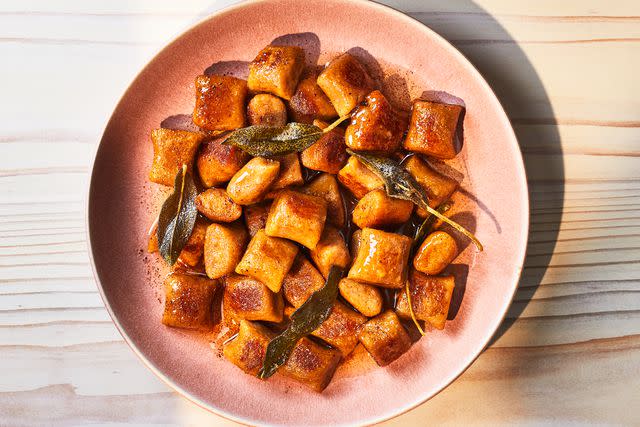The Best Gnocchi Is Super Basic
Going back to basics helped this chef rediscover why sometimes the simplest way is all you need.

Westend61 / Susan Brooks-Dammann / Getty Images
The other night I needed something quick to cook and found some Bolognese and gnocchi in the freezer. Watching the little dumplings bobbing around in boiling water, I considered my, at times complex, feelings about gnocchi di patate. To clarify, they are not a comfort food to me, not something I run to when I need reassurance or a spirit boost. These gnocchi are simple, timeless, and refined — the black Hugo Boss suit of food. They are my luxurious and sublime escape from this mortal realm when they are well-made. These weren’t well-made, but I was, nonetheless, pondering my relationship with them.
In the early '90s, I worked in “fine dining” restaurants in Portland, Oregon. The quotes are sarcastic, as PDX was still a culinary backwater at that point. Sure, there was good food to be found, but while an edible whirlwind was happening farther down the West Coast, it hadn’t reached Stumptown yet. I had a job with some people who’d come up from LA to “show us how they do it in the big city.” The menu was a weather vane of America destroying all that was ever good and beautiful in items like chevre, sun-dried tomatoes, and balsamic vinegar — all served with a random herb sprig and some dipping oil for your bread. In the chef’s defense, the “slick” ownership and management kept his hands bound regarding the menu. It was so far from the beauty and simplicity of what I’d been able to glean, in the pre-internet era, from magazines happening elsewhere. It was intellectually lazy and dishonest, and I had to leave.
When I said that the city had some good food, I wasn’t being generous. There were some good restaurants; they just weren’t “modern.” As a less staid option, one of the trends that swept the country at that time was the proliferation of Italian restaurants, which appealed to me.
Like many, I was familiar with red sauce dishes and little else of the cuisine. Refusing to let my ignorance stop me, I faked my way into my first chef position. Subsequently, I gave myself a crash course in regional Italian cooking via cookbooks that I still have today. The complexity of flavors and textures wrapped in deceptively simple ingredients didn’t just speak to me; it gave me cries of welcome and wrapped me in their loving arms. I explored many new dishes and preparations.
Eventually, I found gnocchi. Like a lot of food then, I’d never eaten it before, so I had zero points of reference as to what was good gnocchi or bad. I fumbled through a few variations and finally hit the place of beauty, pillow-light, no doughiness or raw floury taste. I hate even to use this word, but it was transcendent. The idea that you could manipulate some flour, potato, and egg into something so luxurious smacked me upside the head.
I couldn’t justify pairing red sauces with my gnocchi; the combination reduced the dumplings to a vehicle for the sauce rather than maintaining their starring role. There’s no way they would be singing backup on my plates. Brown butter or prosciutto and sage with just a splash of cream were opportunities to experience the textural beauty of these little potato logs. This went on for several years but the world of food, the city, and I, moved forward, and gnocchi started to seem like a relic to diners and myself. I would still make it at home, but it wouldn’t see a place on my menus again for over a decade.
Related: 20 Reasons to Make Homemade Gnocchi This Fall
I’ll skip the interim years; 2010 found me opening my first restaurant. Part of my model was to change my menu weekly, depending upon what was coming from the local fields or water. I also had a hard and fast rule that we would never repeat a dish. As rigid and inflexible as that might seem, it was designed to constantly push forward, innovate, and flex our creativity past perceived limitations. Nobody, especially me, would rest on their laurels in my kitchen. That didn’t come without some pitfalls. When you find yourself making savory Dutch babies filled with mustard-macerated strawberries, you’re playing in the deep end of the pool. Something as simple as gnocchi and brown butter seems quaint under that lens.
After a few years of pushing myself and my staff to out-weird the neighbors, I realized I’d passed the neighbors and most of the region by a long time ago. But I was stuck, in a sense. One week I really just wanted to make a bowl of chili. You know, chili. Braised meat, beans (sorry, Texas), chiles, and spices. But I couldn’t do that. My entire approach to food in this iteration of myself had been to push boundaries. Expectations from diners, critics, judges, and peers — all of my own creation, I’m well aware — prevented me from doing something so straightforward. I don’t remember all the components of the chili-like dish I wound up making, but I remember it taking longer to garnish the plate than it did to heat it. That’s when I started questioning myself and my approach to food and wondering if I was becoming intellectually dishonest and lazy, creating complicated food just to "elevate” it.
I resolved my crisis of faith by going back to the basics. If I could push my creativity beyond any limit I thought I had, why couldn’t I re-examine cooking as a whole and seek to make the best possible version of heretofore simple dishes? I put things so seemingly trivial as how to best roast a pepper or use mirepoix to its fullest extent as a builder of body and depth in a dish under a microscope. Career-wise, this wasn’t the best move. I suddenly fell off the national radar, and all the local press could understand was that Greg wasn’t putting gorgonzola and blueberry ice cream on top of blistered green beans anymore. But I’d freed myself from the corner I’d painted myself into and was being intellectually honest and curious again. I still couldn’t quite put a plate of gnocchi on my menu, but I had the freedom to play with such things.
For my last fancy charity fundraiser before retiring, I confused everyone in attendance with smoked eggplant gnocchi tossed with 'nduja-braised collards. A local food critic could only describe the plate as “unexpected,” not refined enough for the black tie affair. It was the equivalent of your grandmother mentioning your new haircut as “interesting.” It was just another thing that went over peoples’ heads. But even that version was still so far from the simple beauty and bliss of gnocchi di patate. But that wouldn’t have translated to the audience, so I had to add something elevated to justify the high-dollar ticket fee. (Honestly, there’s never been even a gossamer-thin thread of me that wanted to cook fancy food for wealthy people, but that is a bit of introspection for another time.)
I’ve had three years away from restaurants to examine where I started, how I evolved, and what I could have done differently over 36 years in the business. Staying true to yourself and staying relevant can often be at odds with each other. It’s good to grow and experiment and vitally important never to stop learning, but use caution. To deny yourself and your diners the refinement and joy of something so simply elegant due to a collective short attention span is a great disservice. It’s also the first wobble in the wheel away from self-truth. Remember, too, that everyone knows only the version of you that you present to them. Consider that version carefully and avoid constraints and limitations, allowing yourself the room to remain intellectually honest and driven. They are not mutually exclusive.
I’ll leave you with this piece of my heart: my gnocchi recipe. After boiling a large russet potato, put it through a ricer. Gently mix the potato with eggs and flour. Gently shape the gnocchi and poach them. Something that simple can’t be luxurious. Or can it?
Gnocchi Parisienne

Greg DuPree / Food Styling by Victoria Granof / Prop Styling by Christine Keely
Potato Gnocchi with Butter and Cheese

Maxwell Cozzi
Ossola-Style Gnocchi with Sage-Butter Sauce

For more Food & Wine news, make sure to sign up for our newsletter!
Read the original article on Food & Wine.

